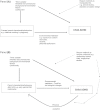What have we learnt about the causes of ADHD?
- PMID: 22963644
- PMCID: PMC3572580
- DOI: 10.1111/j.1469-7610.2012.02611.x
What have we learnt about the causes of ADHD?
Abstract
Background: Attention deficit hyperactivity disorder (ADHD) and its possible causes still attract controversy. Genes, pre and perinatal risks, psychosocial factors and environmental toxins have all been considered as potential risk factors.
Method: This review (focussing on literature published since 1997, selected from a search of PubMed) critically considers putative risk factors with a focus on genetics and selected environmental risks, examines their relationships with ADHD and discusses the likelihood that these risks are causal as well as some of the main implications.
Results: No single risk factor explains ADHD. Both inherited and noninherited factors contribute and their effects are interdependent. ADHD is familial and heritable. Research into the inherited and molecular genetic contributions to ADHD suggest an important overlap with other neurodevelopmental problems, notably, autism spectrum disorders. Having a biological relative with ADHD, large, rare copy number variants, some small effect size candidate gene variants, extreme early adversity, pre and postnatal exposure to lead and low birth weight/prematurity have been most consistently found as risk factors, but none are yet known to be definitely causal. There is a large literature documenting associations between ADHD and a wide variety of putative environmental risks that can, at present, only be regarded as correlates. Findings from research designs that go beyond simply testing for association are beginning to contest the robustness of some environmental exposures previously thought to be ADHD risk factors.
Conclusions: The genetic risks implicated in ADHD generally tend to have small effect sizes or be rare and often increase risk of many other types of psychopathology. Thus, they cannot be used for prediction, genetic testing or diagnostic purposes beyond what is predicted by a family history. There is a need to consider the possibility of parents and siblings being similarly affected and how this might impact on engagement with families, influence interventions and require integration with adult services. Genetic contributions to disorder do not necessarily mean that medications are the treatment of choice. We also consider how findings might influence the conceptualisation of ADHD, public health policy implications and why it is unhelpful and incorrect to dichotomise genetic/biological and environmental explanations. It is essential that practitioners can interpret genetic and aetiological research findings and impart informed explanations to families.
© 2012 The Authors. Journal of Child Psychology and Psychiatry © 2012 Association for Child and Adolescent Mental Health.
Figures
References
-
- Alberts-Corush J, Firestone P, Goodman JT. Attention and impulsivity characteristics of the biological and adoptive parents of hyperactive and normal control children. American Journal of Orthopsychiatry. 1986;56:413–423. - PubMed
-
- Antshel KM, Fremont W, Roizen NJ, Shprintzen R, Higgins AM, Dhamoon A, Kates WR. ADHD, major depressive disorder, and simple phobias are prevalent psychiatric conditions in youth with velocardiofacial syndrome. Journal of the American Academy of Child and Adolescent Psychiatry. 2006;45:596–603. - PubMed
-
- Arnold LE, DiSilvestro RA. Zinc in attention-deficit/hyperactivity disorder. Journal of Child and Adolescent Psychopharmacology. 2005;15:619–627. - PubMed
-
- Bailey A, Le Couteur A, Gottesman I, Bolton P, Simonoff E, Yuzda E, Rutter M. Autism as a strongly genetic disorder: Evidence from a British twin study. Psychological Medicine. 1995;25:63–77. - PubMed
Publication types
MeSH terms
Grants and funding
LinkOut - more resources
Full Text Sources
Medical


